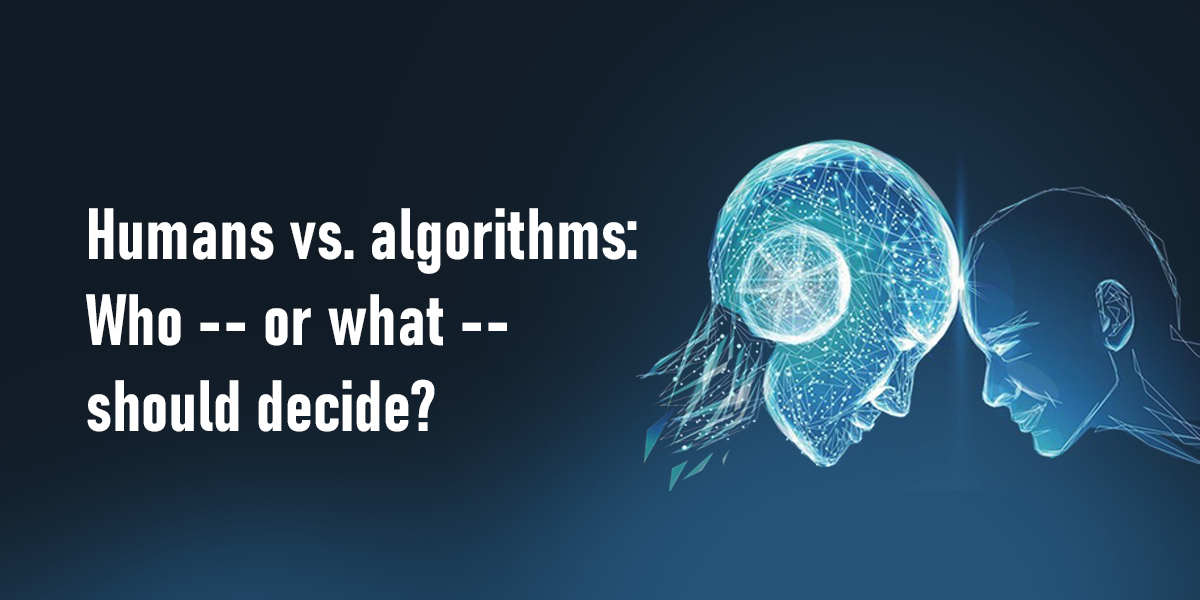Humans vs. algorithms: Who -- or what -- should decide?

Data Scientist
Deep learning and machine learning specialist, well-versed with experience in Cloud infrastructure, Block-chain technologies, and Big Data solutions.
Janaury 06, 2024

Humans vs. Algorithms: Striking a Balance in Decision-Making
In the rapidly advancing landscape of technology, the debate surrounding decision-making powers — whether vested in humans or algorithms — has gained unprecedented prominence. As artificial intelligence (AI) and machine learning (ML) algorithms become increasingly sophisticated, questions about the optimal distribution of decision authority have ignited discussions across various sectors. In this comprehensive exploration, we delve into the nuanced dynamics of decision-making, weighing the strengths and limitations of both humans and algorithms, and ultimately, examining the imperative for a balanced and collaborative approach.
The Rise of Algorithms: Precision and Efficiency
AI and ML algorithms have permeated nearly every facet of modern life, from personalized content recommendations on streaming platforms to predictive analytics in healthcare. The allure lies in their ability to analyze vast datasets, detect patterns, and make predictions or decisions at speeds incomprehensible to human capabilities. This surge in algorithmic decision-making has led to undeniable benefits:
1. Precision:
Algorithms excel in processing large volumes of data with precision, minimizing errors associated with human biases or subjectivity. In fields such as finance and healthcare, where accuracy is paramount, algorithms offer unparalleled precision.
2. Efficiency:
Algorithms operate at incredible speeds, performing complex computations and analyses in fractions of a second. This efficiency is a game-changer in scenarios demanding real-time decision-making, such as stock trading or autonomous vehicle navigation.
3. Scalability:
Algorithms can effortlessly scale their operations to handle vast datasets and tasks concurrently. This scalability is particularly advantageous in industries dealing with exponential data growth, such as e-commerce platforms or social media networks.
4. Consistency:
Algorithms provide a consistent decision-making framework, unswayed by emotions or external influences. This attribute is valuable in scenarios where uniformity and adherence to predefined criteria are critical.
The Human Touch: Intuition and Ethical Considerations
While algorithms bring a plethora of advantages to decision-making processes, the irreplaceable human touch introduces a distinct set of attributes that algorithms, by their nature, lack. Here are key aspects where human decision-makers shine:
1. Intuition and Creativity:
Humans possess a unique capacity for intuition and creativity — qualities that are challenging for algorithms to replicate. In domains requiring innovative problem-solving or understanding nuanced contexts, human intuition remains unparalleled.
2. Emotional Intelligence:
Understanding and navigating complex human emotions is a realm where algorithms often fall short. Humans bring emotional intelligence to decision-making, crucial in scenarios such as leadership, counseling, or customer service.
3. Contextual Awareness:
Humans inherently grasp the subtleties of context, cultural nuances, and evolving dynamics. In decision-making, especially in fields like law or diplomacy, this contextual awareness proves indispensable.
4. Ethical Considerations:
Ethical decision-making involves a profound understanding of societal values, moral principles, and the potential impact on individuals and communities. Humans, guided by their moral compass, can navigate ethical complexities that algorithms may struggle to comprehend.
The Pitfalls and Biases: Unveiling the Dark Side of Algorithms
While algorithms exhibit remarkable capabilities, they are not immune to shortcomings. One of the most significant challenges is the potential for bias, both in the data they are trained on and the design of the algorithms themselves. Some critical considerations include:
1. Data Bias:
Algorithms learn from historical data, inheriting any biases present in the datasets. If historical data reflects societal prejudices or systemic inequalities, the algorithm may perpetuate and exacerbate those biases.
2. Lack of Contextual Understanding:
Algorithms operate based on patterns and correlations found in data, but they often lack the contextual understanding that humans naturally possess. This deficiency can lead to misinterpretations and flawed decisions in nuanced situations.
3. Limited Adaptability:
Algorithms are designed for specific tasks and may struggle when faced with scenarios beyond their predefined scope. Humans, on the other hand, exhibit adaptability and the ability to apply knowledge across diverse contexts.
4. Lack of Accountability:
In instances of algorithmic decision-making gone awry, determining accountability can be challenging. Unlike humans who can be held responsible for their actions, algorithms may operate in a black box, making it difficult to trace decision pathways.
Striking a Balance: The Imperative for Collaborative Decision-Making
Recognizing the strengths and limitations of both humans and algorithms, a prevailing consensus is emerging — the need for collaborative decision-making. A symbiotic relationship, leveraging the strengths of each, holds the key to optimizing decision processes across various domains.
1. Human Oversight:
Introducing human oversight in algorithmic decision-making is crucial to mitigating biases and ensuring ethical considerations. Humans can provide the necessary context, interpret results, and intervene when algorithms produce outcomes that may be ethically or morally questionable.
2. Ethical AI Design:
Developers and data scientists play a pivotal role in crafting algorithms that adhere to ethical standards. Implementing diverse and representative datasets, transparent decision-making processes, and incorporating ethical considerations into algorithmic design are imperative steps.
3. Continuous Monitoring and Adaptation:
Algorithms should be subject to continuous monitoring and adaptation. As societal norms evolve, algorithms must be updated to reflect these changes. Regular audits and reviews can help identify and rectify biases or inaccuracies that may emerge over time.
4. Education and Training:
Fostering a deeper understanding of AI and algorithms among decision-makers is essential. This involves providing education and training to humans involved in overseeing or interacting with algorithmic systems, enabling them to make informed decisions about when to rely on algorithms and when to exercise human judgment.
Case Studies: Real-World Applications of Collaborative Decision-Making
1. Healthcare Diagnostics:
In healthcare, algorithms excel in analyzing medical images and diagnostic data, providing rapid and accurate assessments. However, human doctors bring years of training, clinical experience, and the ability to empathize with patients. The most effective approach involves collaborative decision-making, where algorithms aid doctors in diagnosis, allowing them to leverage their expertise and contextual understanding.
2. Financial Trading:
Algorithmic trading has revolutionized financial markets, executing trades at speeds beyond human capability. However, major market fluctuations and unforeseen events often require human intervention. A collaborative model, where algorithms handle routine transactions and humans intervene strategically during volatile periods, ensures a balanced and resilient trading strategy.
3. Criminal Justice:
Predictive policing algorithms aim to optimize law enforcement strategies. However, concerns about biased predictions and potential perpetuation of systemic inequalities have prompted a reevaluation. Collaborative decision-making involves incorporating human judgment to interpret algorithmic recommendations, ensuring that ethical considerations and community context are factored into policing strategies.
4. Recruitment and HR:
Algorithms in recruitment processes promise efficiency and objectivity. Yet, they must contend with challenges related to bias in training data and the inability to capture intangible qualities. Human involvement is crucial in interpreting algorithmic outputs, considering candidates holistically, and addressing concerns related to fairness and diversity.
The Future Landscape: Integrating the Best of Both Worlds
As we navigate the evolving landscape of decision-making, the trajectory points towards a future where humans and algorithms complement each other synergistically. Achieving this harmonious integration requires ongoing research, ethical considerations, and a commitment to transparency. Here are key considerations for shaping the future landscape:
1. Ethical AI Governance:
Establishing robust frameworks for ethical AI governance is paramount. Regulatory bodies, industry stakeholders, and AI developers must collaborate to set standards that prioritize fairness, accountability, and transparency in algorithmic decision-making.
2. Public Awareness and Engagement:
Educating the public about the role of algorithms, their capabilities, and potential biases is essential. Informed citizens can advocate for responsible AI practices, prompting organizations to prioritize ethical considerations in the development and deployment of algorithms.
3. Interdisciplinary Collaboration:
Collaboration across disciplines — involving technologists, ethicists, psychologists, and policymakers — is crucial. This interdisciplinary approach ensures that decisions about the design, deployment, and oversight of algorithms are well-rounded and consider diverse perspectives.
4. Continuous Research and Innovation:
The field of AI and machine learning is dynamic, with rapid advancements and discoveries. Continuous research and innovation are imperative to refine algorithms, address biases, and enhance their compatibility with human decision-making.
5. Legal Frameworks:
Developing legal frameworks that govern the use of algorithms and delineate responsibilities in decision-making is essential. These frameworks should address issues of accountability, transparency, and the right to appeal algorithmic decisions.
Conclusion: The Collaborative Future of Decision-Making
In the grand tapestry of decision-making, the narrative is evolving towards collaboration — a harmonious interplay between human judgment and algorithmic precision. As we navigate this intricate dance, the imperative is clear: to leverage the strengths of both humans and algorithms while mitigating their respective limitations.
The future landscape of decision-making holds promise, provided we tread with diligence, ethical foresight, and a commitment to continual improvement. Through interdisciplinary collaboration, ethical AI governance, and a collective dedication to transparency, we can shape a future where decisions are not dictated by humans or algorithms alone but emerge from a symbiotic relationship that harnesses the best of both worlds. In this collaborative future, decision-making becomes not a battleground of supremacy but a synergistic partnership that propels us towards innovation, fairness, and a more enlightened era of progress.













